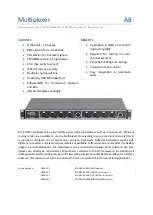
̶ 3 ̶
● Auxiliary Units (Prefixes)
There are a number of measurement units used for multimeters.
Volt (V), ampere (A) and ohm (Ω) are most widely used as
measurement units to indicate electrical potential, current and
resistance. However, it is not always straitforward to handle these
units as they sometimes too large or too small for practical use or
calculation. Prefixes are therefore used as auxiliary units to simplify
the usage of such measurement units.
The following table shows some of the examples:
Auxiliary Unit
M
k
m
μ
n
P
Read
mega-
kilo-
milli-
micro-
nano-
pico-
Multiply
10
6
10
3
10
-3
10
-6
10
-9
10
-12
Example
2MΩ
=
2000kΩ
2kΩ
=
2000Ω
250mA
=
0.25A
50μA
=
0.05mA
200nF
=
0.2μF
1000pF
=
0.001μF
● Notes on Voltage & Current Measurements
It is important to understand the basic differences between current
and voltage measurements for proper use of multimeters.
Voltage measurements are designed to detect potential difference
between two points. Make certain that the multimeter is connected in
parallel with the circuit under test.
Current measurements are intended to monitor the consumption of
current in the circuit resulting from the application of voltage. Make
sure to connect the multimeter in series with the circuit under test.
Generally speaking, the internal resistance of a voltmeter should
preferably be larger, while that of an ammeter should be smaller. If
the multimeter is erroneously connected in parallel with a circuit for
current measurements, the likely result will be the flow of excessive
current and aubsequent damage to the fuses and other electronic
components. To avoid such a potential danger it is necessary to have
a good understanding of voltage and current measurements.
Summary of Contents for KEW 1109
Page 1: ...INSTRUCTION MANUAL ANALOGUE MULTIMETER KEW 1109S ...
Page 30: ... 28 PCB Component Layout Drawing Fig 11 ...
Page 32: ... 30 CIRCUIT DIAGRAM ...
Page 33: ... 31 MEMO ...
Page 34: ... 32 MEMO ...
Page 35: ......






































